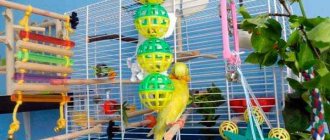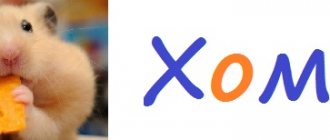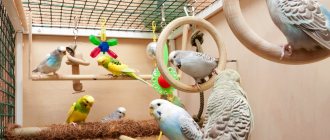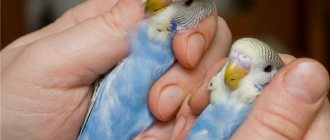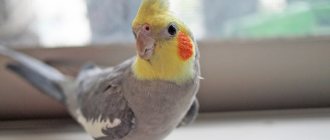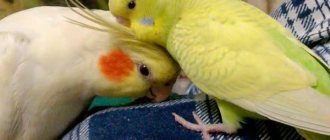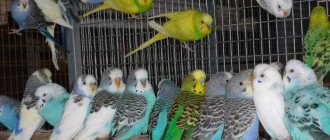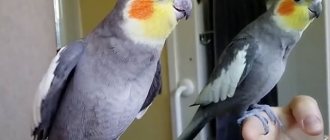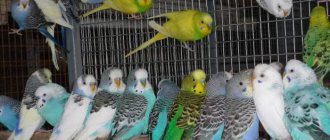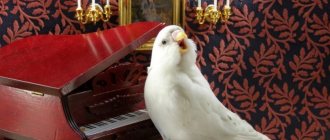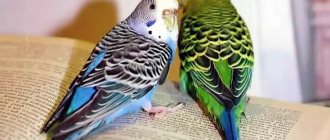If you purchase a budgerigar from a breeder, they will offer chicks with a small ring on their paw. It indicates that the bird was purchased from a breeder and also has certain characteristics.
With the help of such a ring, the age of the parrot, its gender and other parameters are determined. If you plan to attend exhibitions, then the presence of this product is a prerequisite for participation.
In the article we will talk in detail about why parrots are banded.
- Reasons for bird banding
- Is it necessary to band a bird?
- Choosing the right product Types of rings by material
- Color coding
- Open and closed
- Where to buy a ring
Reasons for bird banding
With the help of a ring that is put on the chick's foot, the buyer can get a lot of information about the bird. Initially, the products were put on birds to obtain information about migration.
Scientists used special sensors to determine what distances birds cover during migration. Over time, information has appeared that the birds return home periodically, which is a significant characteristic of a particular species. Scientists obtain data on how often birds stop to feed or rest during migration.
Later, the rings began to be used by breeders of various breeds of parrots. With the help of such rings it was possible to determine the age of the bird, its origin, and also to track its location if, for various reasons, the parrot flew out of the cage or aviary.
Problems with a parrot's legs
If the parrot is in good health and has healthy legs, it walks freely and jumps from perch to perch. While eating, it stands on one paw, and the other one holds a piece of fruit and pecks it. When he goes to bed or dozes, he tucks one limb under his abdomen and lets it rest.
Changed behavior may indicate that the parrot has pain in one leg:
- the bird often picks it up and fiddles with its beak;
- stops walking, tries to crawl;
- limps, cannot walk;
- trembles constantly;
- itches against surrounding objects, cage bars;
- falls from the perch during sleep and wakefulness.
Judging by the appearance of the pelvic limbs, it becomes clear that not everything is all right with the parrot:
- the skin takes on a strange shade and feels cold or hot to the touch;
- blood or ichor oozes from the leg;
- the epithelium peels off and grows, bumps appear;
- ulcers appear on the fingers;
- the joints swell, the paws differ noticeably in thickness from each other.
Next, we will consider several situations that cause the owner to worry about the pet’s paws.
Is it necessary to band a bird?
If a person plans to keep a bird at home, then he has a question about the need and advisability of ringing. The procedure is mandatory for conscientious breeders who are engaged in high-quality breeding of birds, and also try to improve certain characteristics of specific parrots.
Thanks to the process, the possibility of using the bird for breeding is determined. It allows you to avoid serious mistakes, and you can also choose an individual with the desired heredity. If a bird is bought at the market, then without a ring the buyer cannot accurately determine the age or sex of the chick.
Some even well-known breeders do not use banding, since they themselves track the age of the chicks.
In fact, many people who are seriously involved in breeding parrots easily remember pairs and broods, but the breeder can always deceive the buyer by providing him with incorrect information in order to quickly sell a particular individual. If the breeder does not use rings, then statistics show that all the chicks he sells remain two months old for a long time.
Paws refused
Paralysis of the pelvic limbs occurs when there are disturbances in the functioning of the nervous system. If a parrot's leg fails, it looks pitiful: it tries to get up, but falls to the side and can only crawl, helping itself with its beak.
This condition is caused by stress, severe bruises, and some illnesses. As an example, a concussion after a bird hits the glass. At first, the legs do not stop functioning, other symptoms appear:
- lack of coordination of movements;
- convulsions;
- lack of concentration;
- loss of consciousness.
Choosing the right product
If a decision is made about the need to band parrots, then it is important to choose a suitable ring for this purpose. It is advisable to use non-removable products that are put on small chicks and are not removed later. This allows you to prevent their replacement in the future, so the element acts as an analogue of a passport for any bird.
There are detachable rings, but careless breeders can replace them at any time. Therefore, buying a bird with such a product is represented by a lottery.
Types of rings by material
Parrot rings are made from different materials. Previously, aluminum was used for these purposes, so the bird’s number, the breeder’s address and the date the chick was born were stamped directly onto the product.
Nowadays breeders prefer to use plastic rings that are more affordable and easy to use. They easily contain information about the wavy's number, its age and the address of the breeder. Additionally, such products have different colors, which indicate the region in which the parrot was bred. The ring is easy to see without first catching the wavy.
Color coding
The bird ring contains a lot of useful information. This includes:
- the address where the bird was bred;
- Date of Birth;
- country of origin;
- identification code assigned to each breeder, as well as his initials;
- number and size;
- sometimes the index and abbreviation of the club or organization to which the breeder belongs is indicated.
Using a letter abbreviation, the country in which the parrot was bred is determined. For example, for Russia the letters RU or RUS are used, and for Ukraine - UA. The colors in Russia indicate the year or region of birth of the parrot.
The standard color for 2021 is black and for 2021 it is light green. If the breeder is represented by a member of any club or society, then he is assigned an identification code. Using this value, the buyer will be able to obtain information about the breeder via the Internet or during a personal visit to the club.
Open and closed
Closed designs are otherwise known as permanent designs and are also commonly used by professional breeders. Such a ring cannot be removed from a parrot’s paw, and ringing is only possible for a chick. The procedure is performed approximately a week after the chick hatches from the egg.
Only with such a ring can a parrot be exhibited at an international exhibition. Products are made of aluminum or plastic, and also have specific dimensions and diameters. Additionally, they have colors that confirm the year of birth of the bird.
Breeders use removable or open rings so as not to forget about the specific characteristics of a particular chick. They are usually made of plastic and come in different colors. If necessary, such a ring can be removed and replaced with another product.
Where to buy a ring
Sometimes such products are sold directly in pet stores, and they can also be ordered on the websites of these organizations. If the breeder lives in a region where stores do not offer rings, then you can order them from a club.
It is not recommended to use home-made rings, as they can harm the bird, and are also not accepted for participation in exhibitions.
Growths, peeling
Every parrot develops tumors on its legs at least once in its life. Ugly growths are a consequence of processes in the skin caused by the activity of parasites. A common infectious disease among birds is knemidocoptic mange, a scabies mite.
Microorganisms colonize unfeathered areas of the skin, make passages in them, feed on particles of the epithelium and secrete their waste products inside. Moving in the skin, the scabies mite causes unbearable itching; the bird constantly itches and pecks at the metatarsus. The skin becomes loose, peels, and the surface layer crumbles.
Treatment for scabies is simple, but long-term. The affected paws of the parrot are treated with aversectin ointment according to a special scheme. Unfortunately, recovery does not guarantee that the parrot will not contract the disease again in the future. Ticks are carried on tree branches and used equipment. You can become infected from other birds if quarantine is not observed.
Banding rules
The procedure is performed only by an experienced breeder and owners should not do this at home. Only if a person is engaged in bird breeding, the procedure is carried out taking into account the following rules:
- non-removable rings are used for small chicks that hatched from the egg about a week ago;
- removable products can be used at any period of the wavy’s life;
- if the procedure is performed on an adult bird, then it must be caught using nets or traps if it is not accustomed to handling;
- if the process is being implemented for a chick, then for the first time you will have to use the help of an ornithologist-ringer who has the necessary skills to hold the bird correctly without damaging its wings or legs;
- the ring is placed directly on the tarsus, which is the bone between the shin and toes, and can also be put on the shin if the bird has long legs;
- to complete the process, the chick’s fingers are folded, and then the ring is pulled out;
- After the procedure, measurements are taken to ensure the correctness of the result.
If ringing is carried out by a club member, then after putting on the ring a special statement is drawn up containing information about the breeder and the bird. This information is transmitted to the employees of the Banding Center. Some breeders adhere to the rule that in even-numbered years the ring is put on the right paw. The work is done calmly and carefully, and within a week you need to check whether the ring has come off.
Hot paws
The legs overheat if the pet moves actively. A parrot's paws become hot if it intends to attack an opponent, peck its owner, or grab a tasty morsel. It depends on your temperament. In sluggish, boring individuals, the limbs are almost never hot.
You can talk about pathology if certain areas of the paws are much warmer. Typically, with joint diseases, the affected areas are hot, while the remaining areas are at normal or slightly lower temperatures. When a bird feels bad, it sits lower on the crossbar and spreads its legs wide.
What to do when you find a wavy with a ring
If a person finds a budgie with a ring, then the employees of the Ringing Center must be informed about this. The procedure is performed by phone, email or in person visiting the organization. The bird will have to be returned, since based on the records it is easy to find its owner.
If a citizen simply saw a parrot on the street, then it is still advisable to inform the organization’s employees about this, indicating the time and place of the meeting.
Some breeders even buy expensive rings with GPS sensors, which make it easy to find a lost pet, but this option is usually used for unique representatives of the breed.
Vitamins and minerals
Feel free to experiment with vegetables and fruits that are rich in vitamins. If a parrot does not usually show interest in succulent food, then it may change its preferences during the molting period. But when all attempts to diversify the diet are unsuccessful, you will have to switch to special vitamin complexes for birds.
The cell must contain mineral components:
- sepia;
- chalk;
- eggshell;
- mineral stone.
If a budgerigar sheds frequently, its body is depleted and needs an increased dose of minerals. One of the important elements for feather growth is sulfur. The veterinary drug Tsamax has no contraindications, so it can be used when changing plumage.
What does the inscription on the bird's ring mean?
What does the inscription on the bird's ring mean?
Post by Marina » 03 Nov 2012, 23:56
Birds kept in captivity are mostly ringed with permanent rings of a certain standard. Until recently, Russian fanciers did not have the opportunity to band their birds with rings made in the factory, with markings applied to them in accordance with all global rules.
The birds were ringed with homemade, often quite traumatic rings, or not ringed at all.
But with the opening of borders and the disappearance of the so-called. “Iron Curtain” in the late 80s and early 90s, our fans throughout the post-Soviet space had the opportunity to purchase rings with a given COM annual color and marking.
One of the first ornithological clubs revived after the collapse of the USSR was the Moscow City Club of Songbird and Exotic Bird Lovers.
Breeding work was restored, contacts with amateurs abroad began to be organized, the club was one of the first in Russia to begin systematically keeping records of breeders, and introduced mandatory ringing of breeding stock with one-piece rings made to order abroad according to COM standards.
After some time, other Moscow ornithological clubs and associations joined in the mandatory ringing, in particular FPRK, Moscow Russian Canary Club
Today, the popularization of civilized breeding of ornamental birds by our lovers continues, more and more ornithological clubs, private nurseries that carry out systematic breeding work, breeding club registries where the numbers of rings issued to club members are entered, which can be used to determine not only the age of the bird , but also the country of origin, breeder, etc.
Ringing birds with standard closed rings eliminates/reduces the possibility of fraud with the birds being sold.
If it is possible to argue about the quality of the bird, then the indicated data: country of breeding, year of breeding, exclude any reason for doubt.
Here we come to the next question
What do they write on the bird ring?
by default all inscriptions are written in Latin
1. The color of the ring indicates the year, but the last two digits of the year are also included - 19 (2019)
2. Initial letters of the country where the bird was born
3. Abbreviation of the organization that issued the ring
4. Personal number of the breeder.
5. Serial number of the ring.
6. Letter designation of ring size
In every European country there are many ornithological clubs and therefore the abbreviation of the club is often marked on the ring, rather than the country itself; here are a few examples:
RU or RUS - Russia
3A - Ornithological Internet Portal THREE A
RBC - Russian Club of Budgerigar Lovers
MK - Moscow Club of Songbirds and Exotic Bird Lovers
MCRC - Moscow club "Russian Canary"
ZSV – All-Ukrainian public organization “ZOOСВІТ”
USC – Ukrainian Southern Club of Songbirds and Exotic Bird Lovers
Examples of decoding rings -
ΑΟΒ 18 Ε036 188 HΒ
AOB - country and organization (Belgium) 18 - year of birth 2021 E - 2.9 mm ring diameter 036 - bird number 188 HΒ - breeder code
ΕΟΟ 980 D19 S26
EOO - country and organization (Greece) 980 - bird number D - ring diameter, 2.7 mm 19 - year of birth, i.e. 2021 S26 - breeder code
Landesverbandsnummer 23 ltd. Vereinsnummer im Landesverband 08 lfd. Mitgliedsnummer im Verein 12 Jahrgang 16 lfd. Vogel-Ringnummer 123
National Association (Society) Number 23 serial number of the club in the national association 08 serial number of the club member 12 Born (year) in 16 serial number of the bird 123
Most European rings look identical.
Banding
is a method of individually marking birds used in ornithology.
He is able to tell a lot about the lifestyle, biology and ecology of bird populations and species. It is especially important that banding plays a large role in the study and conservation of rare species. A little history
According to Smithsonian magazine, ringing was first used by Danish schoolteacher Hans Christian Martensen. In 1899, he ringed 165 starlings. Hans Martensen used metal rings that he made himself. He indicated his name and address on them. The experiment was a success: some of the birds returned to their nesting places and subsequently the method became very widely used in science. Over the following years, birds began to be ringed in Germany, Hungary, Holland, the USA, Yugoslavia, Sweden and other countries.
In our country, the first experiments in individual tagging of birds have been known since 1892, when Baron F.E. Falz-Fein conducted experiments by putting rings around the necks of cranes. Since 1907, rings have been worn on feet in Russia. (Collars are still used to mark some birds, for example, geese).
Over time, it became clear that the bird ringing system must be centralized for adequate data processing. In 1924, special rings with the inscription “Moscow. BYUN" (Biostation of young naturalists). Since this year, all information about birds found/harvested has flowed here. In subsequent years, the BYN bird banding bureau was named the Bird Banding Center
, which continues to this day.
Why are birds ringed?
Banding can provide a lot of information. First of all, these are answers to questions about migration. Many birds travel thousands of kilometers during seasonal movements, and it was the ringing method that made it possible to discover the main routes for long-distance bird migrations. Over time, information has accumulated about which birds and in what numbers return to their places of birth, and this is a very important ecological characteristic of the species. In addition, by observing/capturing a ringed bird in a certain place, scientists obtain information about their life activities: for example, where and when the bird stops to feed and rest. Such data is especially important for the conservation of rare species and their habitats.
Banding and further observation of a tagged bird can tell us about its life expectancy and, accordingly, about some factors that influence this indicator. There is a widely known story about the oldest known bird in the world - an albatross named Wisdom (be sure to read it!). Such unique information was obtained through ringing.
How are birds ringed?
To band a bird, you must either catch it or ring the adult chicks in the nest. Birds are caught with special nets and traps, which are passed around every hour around the clock to prevent the death of the caught bird. The ornithologist-ringer must have the skills to properly hold the bird so as not to damage its limbs.
Rings are made from different materials. In the old days there were only aluminum rings, on which the serial number and address of the ringing center were embossed. Currently, in addition to standard aluminum rings, plastic rings are used. In addition to the number and address, they carry another type of information - the plastic rings are colored differently - each region is assigned its own color. Such rings are visible through binoculars and telephoto lenses, which makes it possible to obtain data without recapturing the bird.
The ring is put on the tarsus (the bone between the toes and the shin), or on the shin (for waterbirds with long legs). Then some measurements are taken and the bird is released. The ring does not harm the birds and does not interfere with their normal functioning. At the end of the ringing season, a general statement is compiled, where all the data about the ringed birds with ring numbers is entered. This statement is sent to the Banding Center.
To obtain data on the movement of a ringed bird, it must be recaptured (or, as already mentioned, “read” the ring using binoculars, if possible). It happens that ringed birds are found dead (for example, under power lines). The return rate of birds is small, since there are many factors that threaten their lives. Birds do not know states or borders, so international cooperation is very important in the matter of ringing. Thus, in 1963, EURING - the European Union of Bird Ringing - was founded. This organization standardizes the method and processes data from all over the world. In our country, the Banding Center is located in Moscow.
What to do if you saw/found a bird with a ring?
If you find a dead ringed bird (or observe a live one and see the ring), you must report this to the Ringing Center. Be sure to write down the time and place of the meeting (biotope), the possible cause of death and the ring number. It is better to return the ring itself to the Center. A letter with this information should be sent to the address: 117312, Moscow, Bird Ringing Center. You will find more information on the Center’s website: https://ringcenter.ru.
Currently, GPS-tagging of birds is increasingly being developed, which provides comprehensive information about their movements. However, this method has many limitations compared to banding: for example, the high cost of the equipment and the impossibility of using it for small birds. Therefore, banding remains an extremely important method for individually marking birds.
If you liked the article, like and subscribe to my channel! If you have any questions, I will be happy to answer them in the comments.
Step-by-step DIY instructions
To make a playground for a parrot, you must first decide where it will be located and take all the measurements that determine the dimensions.
Next, carefully think through all the elements and draw a sketch, select the necessary materials. These can be branches and sawdust from the garden, ice cream sticks (can be used for bridges), ropes from natural raw materials and anything that is needed to fasten the structure and fix it.
Play town for parrots. Parrot playground.
Cut out the base to the required size and make sides on it. Screw in posts or branches on which ladders, bridges and other game elements will be installed.
In addition to the equipment listed, you can make a carousel for the bird. The principle of its creation is not complicated, but it requires patience and the presence of plywood and a jigsaw. Brief instructions:
- Cut a circle to the size of the future structure. Mark the center in which to use a drill to make a hole for the middle axis.
- Make a column of the required height and a wheel with six axles based on the cut out circle. It can be depicted figuratively, for example, in the form of parrots, whose tails are directed towards the center and their heads outward. Draw on paper first. Drill a few holes on the outer ring to hang toys on. Sand all sharp edges with sandpaper.
- Grind off half the threads in the screw so that one side screws into the post and the other side rotates the wheel.
- Hang bells and large colored beads on chains or ropes.
NEW PARROTT PLAYGROUND |
UNPACKING THE PACKAGE | GAME STAND To create ladders, round turned planks or branches are used. Two long and many short. In those that are larger, it is necessary to drill the required number of holes according to the diameter of the crossbars, into which the latter will be inserted. Attached with PVA glue.
Bridges work well from flat planks or popsicle sticks. Holes should be drilled along the edges through which to thread the rope, securing its edges in the right place. Decorate bridges and stairs with bright ribbons, beads and bells. You need to choose entertainment based on your pet’s preferences.
